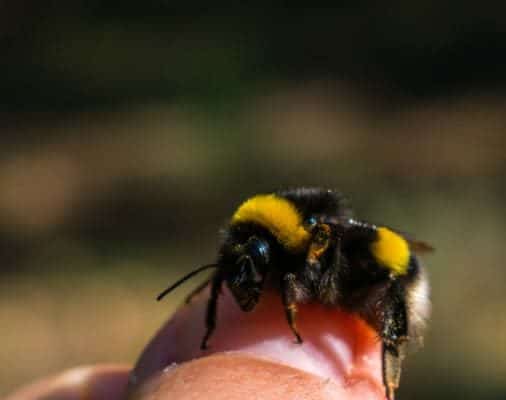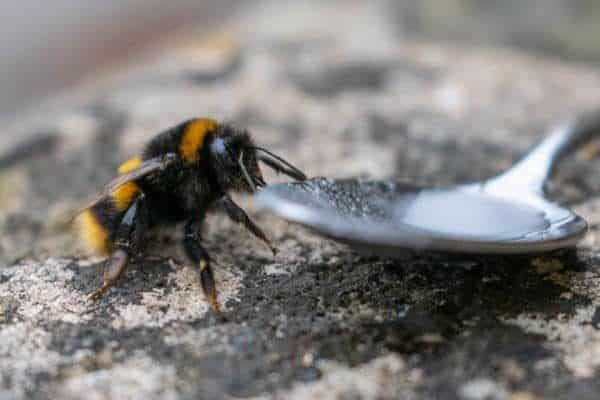
Today, we hear a lot about the dangers the bumblebee is facing. Bees are an enormous part of our food chain and their population is shrinking by the day. People really want to help, however, we as humans need to make sure we have the correct information to go about it the right way. One question that might come to mind is, should you feed bumblebees?
Should you feed bumblebees? You should always try to avoid feeding bumblebees. Unless it is at the beginning of the spring season and the bee is noticeably in peril (not just resting). If you are confronted with this situation you will need to feed the troubled, tired bumblebee a mixture of equal parts white sugar and water. Never feed them honey or brown sugar.
If you are curious about how, what and when to feed bumblebees, then you have come to the right place. We are going to share when the right time to feed a bumblebee is, and how you can safely action this.
Should You Feed Bumblebees?
We have heard in a recently updated report from the United States Department of Agriculture that the bumblebee community is diminishing in the United States as well as Europe. This is a terrifying thought, bumblebees along with all pollinators are vital to the health of our planet.
Thankfully people are becoming more educated and want to try and help these creatures thrive so they build up their population. While this sounds good, in theory, sadly some people have gone about it entirely the wrong way.
It is a common misconception that setting food out for the bumblebees is doing them a huge favor. While this sounds like a good idea, this will do much more harm than good.
Bumblebees fly around and do their part to help this world but surprisingly this is not really their intention. Their main focus is to gather the resources they need to feed themselves and their colony.
In actual fact studies have shown bumblebees more readily than honeybees will divert to artificial alternatives to nectar. They do whatever it takes to feed their colony in the easiest way possible.
If they find a bowl of sugar water on your porch, they might start skipping the nectar-providing flowers altogether, as going to your sugary water is easier. This, unfortunately, means they are not pollinating flowers in the process of foraging for nectar.
So what should we do? The only time you should feed a bumblebee is in early spring when queen emergence is happening or when snow or bad weather may have damaged nectar-bearing flowers. If the new queen dies, her colony will not be built. Meaning the loss of 100’s of bees in the coming months.
Feeding a Queen in the Early Spring
During the first few weeks of spring, the queen bumblebee is quietly emerging and preparing for the long months ahead. You might notice that a queen bumblebee is merely lying around, and they may appear exhausted. This is somewhat true, as the queen bumblebee is trying to prepare.
At this point in her short life, she is very hard at work. The queen has the huge responsibility of building the initial nest for her colony. The production of wax for building requires a lot of energy. She needs to store enough nectar and pollen to sustain her and feed her first round of offspring. This requires a vast amount of foraging which is incredibly taxing on her body.
Unseasonable weather events like a cold snap that brings with it with rain and high winds could mean that nectar and pollen become hard to find in the short term. This break in the supply of resources could be deadly for the queen bee.
But does this mean you should help them?
It really comes down to whether the bumblebee is actually in peril. If you see a queen bumblebee resting in early spring, you can safely move her to another location to get her rest. Bumblebees enjoy high grass or anything with leafiness to keep them guarded and protected from other elements.
If, however, a late frost has damaged early spring flowers, then your food might be a lifesaver.
How to Know if a Bumblebee is in Peril
You need to know the telltale signs as to when a bumblebee is in peril, whether they are a queen or not, as you never want to disrupt a bumblebee’s natural circuit. You see, it is common for bumblebees to rest in one location for up to 45 minutes at a time. So how can you know if they are resting or really need help building their strength back up to fly?
The best thing to do is to observe the bee. By checking on the bee in question from time to time you will soon be able to tell if human intervention is necessary. If you notice that the bee has been grounded for over 45 minutes, they may be in danger. This is especially true if there are no nectar-bearing flowers around, or there has been a major storm that has disrupted food availability.
If this is the case, you can safely feed the bumblebee to get them back on track. However, keep in mind that when you are feeding the bumblebee, it should only be a temporary solution. You never want to make a habit of feeding bumblebees, or they will become accustomed to it. This results in a poor diet for the bumblebee and less pollination of plants occurring.
What to Feed Bumblebees?
The perfect food solution for a bumblebee is simple: mix a small amount of equal parts sugar and water into a small bowl. You don’t need to be overly picky when it comes to the mixture, but you should never put more than 50% sugar so that it’s not a sugar spike. You are trying to provide them the energy they need to go and find a flower with nectar.

In the video below you will see a tired bumblebee unable to fly because it is drained of energy. The guy in the video feeds the bumblebee sugar water revitalizing the bee before it successfully flies away.
Never Use Brown Sugar- Always White Sugar
One thing to remember is that you should never use brown sugar. While it might be okay to swap out white sugar for brown sugar when baking, the same is not true for the bumblebee food mixture. This is because brown sugar is harder for the bees to digest, which affects their overall health.

Never Feed Bumblebees Honey
Another common thought process is that you can feed bumblebee honey- makes sense, doesn’t it? While it might seem like the obvious choice, don’t. Honey can contain unwanted pathogens that can harm a bumblebee, perhaps even kill it. So, therefore, avoid feeding honey to bumblebees at all costs. It might mean you have to ask your neighbor if you can borrow some white sugar.
Plant Nectar-Bearing Flowers
The best thing you can do to help and save the bumblebee population is to plant nectar-bearing flowers in your yard. This will give your bumblebees plenty of opportunities to find food, and you won’t have to worry about supplementing with a sugar water food blend.
If you are thinking about creating a bee-friendly garden, then here is a list of the top bee-friendly flowers to consider planting in your garden:
- Spring: Lungwort, Comfrey, Hellebore, Winter Heather, Crocus, Pieris, California Lilac, Dicentra
- Summer: Wild Strawberries, Aquilegia, Monkshood, Borage, Viper’s Bugloss, Foxglove, Lavender, Geraniums
- Fall: Catmint, Mahonia, Ground Ivy, Verbena, Cosmos, Sunflower, Honeysuckle
There are also some great herb options that support the bee population. Not only are they bee-friendly, but they also double as delicious garnishes you can use for cooking. These include:
- Marjoram
- Chives
- Thyme
- Mint
- Sage
- Rosemary
According to bumblebee expert Dave Goulson: “A bumblebee flaps its wings 200 times per second. That’s a similar RPM to some motorcycle engines.”
Avoid Insecticide
Whether you have hand-crafted, manicured a garden worthy of the top bumblebees or simply have a patch of grass with some trees for the bumblebees to feed and rest on, one thing you need to remember is, never spray insecticide, avoid it wherever possible. You should also never kill ladybirds and lacewings. These insects are beneficial as they eat pesty aphids.
Insecticides are poisonous and can kill bees. If you absolutely have to use insecticide for one reason or another, the best thing to do is to try and spray when it’s dark outside so that there is less of a chance of killing bees. Try and source an insecticide that is designed to only kill off the particular species that is affecting your garden, such as aphids.
The Wrap Up
We are all trying our hardest to help bees thrive and reproduce. We all want to see an increase in their population, but we need to make sure we are going about it the right way.
Bumblebees should only be fed with sugar water when absolutely necessary and must be a temporary solution. The best thing to do is to plant some nectar-bearing plants to intrigue and support the bumblebee colony in your local area.
Sources:
https://www.bumblebee.org/helpbees.htm
https://data.nal.usda.gov/dataset/data-patterns-widespread-decline-north-american-bumble-bees
